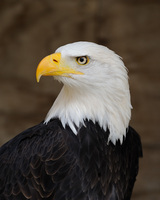 | Back to e-WV
| Back to e-WV
 The West Virginia Encyclopedia
The West Virginia Encyclopedia
 | Back to e-WV
| Back to e-WV
 The West Virginia Encyclopedia
The West Virginia Encyclopedia

The bald eagle was adopted as the national symbol in 1782. At that time, this large bird was not uncommon, and there may have been more than 100,000 bald eagles in what would become the lower 48 states. However, only 417 nesting pairs could be found in 1963, and the species was declared endangered in the continental U.S. in 1969.
The adult bald eagle is distinctively colored with a dark brown body and wings and a white head and tail. The wingspan can reach seven feet. Young eagles are the size of adults, but are dark brown or mottled brown and white; they do not develop a white head and tail until they are four or five years old. Bald eagles mate for life. Two or three eggs are laid in late winter or early spring, and both adults share the responsibilities of raising the young. When they are 10 to 13 weeks old, the young leave the nest. Bald eagles often feed on fish, but they are opportunistic feeders and will feed on other types of meat, including carrion.
Although it is likely that bald eagles nested in present West Virginia when settlers arrived, the first nest was not documented until 1981. The number of nesting pairs has increased steadily over the years. In 2010, there were 36 pairs of bald eagles nesting in the state. By 2022, that number had risen to 130.
The U.S. Fish and Wildlife Service ‘‘downlisted’’ the bald eagle from endangered to threatened status in 1995, and removed it from the list of threatened species in 2007.
Written by Craig W. Stihler